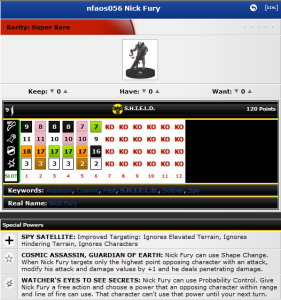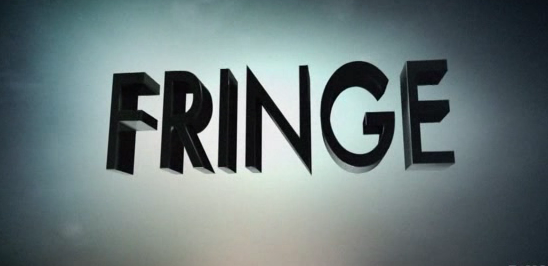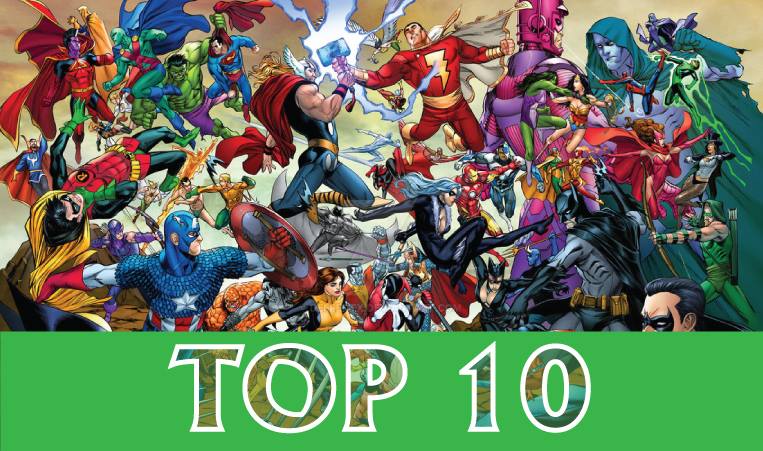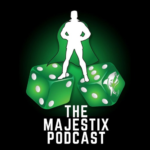The focus of this series will to be to bring the reader’s attention to a different figure each week. These figures will be characters that are quite good and are potentially viable in the modern competitive environment, but don’t seem to show up. These figures are quite good, but from what I can tell, there is no particular reason why they don’t show up in the competitive scene. Also, while the name of the article series may imply that these figures are difficult to get, I will potentially be choosing figures of any rarity. These figures are essentially fringe pieces in the format.
My method of analyzing figures will be:
- Go over what the figure does and what role it can play on a team.
- (If applicable) mention what characters being used competitively that this figure does well against or serves as a counter to.
- (If applicable) Point out if there are any figures that have retired that this figure can replace.
- Go through the figure’s keywords and what figures work well with the figure of the article.
- Make a competitive 300 point modern team with the figure that demonstrates how exactly the figure can perform well and that it is possible to use them competitively.
Without further ado, the subject of the first article will be the Rare Power Ring from Trinity War.
The first thing that stands out about Power Ring is that he possesses the Crime Syndicate Team Ability. This Team Ability is the most important reason why Fast Forces Atomica is played, and it’s always a good Team Ability to see. It reads:
CRIME SYNDICATE – Characters using the Crime Syndicate team ability can use Probability Control. When a roll is ignored because of this team ability an action token must be placed on a friendly character on the battlefield or the roll is not ignored. Uncopyable.
Having access to Probability Control for an entire dial on a 70 point character is already something worth considering. Power Ring has one trait:
The Ring is Killing Me: When Power Ring is given a non-free action other than a move action, after actions resolve roll a d6. On a result of 1-2, deal him 1 unavoidable damage.
This trait is a negative effect, but I see it as a good thing. First, as a general rule, I like these sort of effects that take something away or give a figure some sort of detriment, as they (presumably) decrease the number of points that the character costs. And on Power Ring in particular, his dial is structured so that this damage that he takes can be quite beneficial. More on that later.
Power Ring also has a Movement Special Power:
We’re Going Somewhere?: Power Ring can use Phasing/Teleport. When Power Ring uses the Carry ability, he may carry up to 3 friendly characters that share a keyword with him regardless of their speed symbols.
This power makes Power Ring an effective taxi on a Themed Team, or even one where he shares keywords with other characters. Finally, he has a Damage Special Power:
Power of Volthoom’s Ring: Power Ring can use Perplex. Opposing characters within 6 squares can’t use Perplex to target characters with a point value higher than their own.
The second part of the Special Power may or may not affect a game, but the Perplex is helpful, as is the potential ability to stop a low point opposing support character who is intended to use Perplex.
His Standard Powers for Movement are Running Shot and Phasing/Teleport. In his Attack slots he has Telekinesis and Pulse Wave. Defensively he alternates between Energy Shield/Deflection and Willpower. His only Standard Power in the damage slot is Enhancement.
As a package, what we find in Power Ring is quite the support piece with the ability to attack decently to very well for the point investment. Power Ring starts off with both of his Special Powers as well as Telekinesis and Energy Shield/Deflection. When the game begins, he is meant to be pure support. His We’re Going Somewhere? Special Power allows him to be a great taxi on a Themed Team, even being able to carry characters with the Wing Symbol and others that would normally prevent carrying. Meanwhile, he has Telekinesis in case he needs to help move a friendly character who can’t be carried for reasons other than Speed Combat Symbols, such as a single-based Duo figure or one with Battle Fury. Extra options are a good thing. His Perplex granting Special Power and Crime Syndicate Team Ability solidify him as a great support piece. And he even has a very respectable Defense value from range with his 17-Defense with Energy Shield/Deflection. That first click makes him a decent investment for the points, but what really sets him apart is his surprising ability to attack. His Perplex and Enhancement cover all of his damage slots, making him effective Support on all of his clicks.
Power Ring’s trait does look like it is only detrimental, but it can help him turn into a very capable ranged attacker. On click #2, he picks up Running Shot and Pulse Wave with 10-Attack and 3-Damage, offensively. When taking his Crime Syndicate Team Ability into account on top of the Pulse Wave, he can actually attack at or above his point class. So instead of being only negative, the trait simultaneously works in Power Ring’s favor. I also like that Power Ring’s point investment and primary role on a team mean that he will not necessarily be taking this damage, since his primary top-dial role is being a taxi and taking move actions. Overall, Power Ring is a great support piece that performs well above his points with all his support powers and ability to attack.
 With the retirement of Guardians of the Galaxy, there is a particular figure who Power Ring serves as a suitable if not better replacement for. Jason of Sparta served as the primary taxi for SR Nick “Balls of” Fury, as they shared the Soldier keyword. Now that he’s gone, the search for a taxi who shares a keyword Nick Fury turns up with a number of results, but in my opinion, Power Ring, sharing the Cosmic keyword, is one of the better ones. His Perplex can help buff Nick’s already great stats, and Power Ring having Probability Control means that he can use that Probability Control for Nick. This either means that Nick Fury will have access to two re-rolls while being able to enjoy the variety that his Generic Keywords provide, or Nick will be able to use his long range Probability Control to help out the rest of the team. Additionally, with Power Ring being able to carry 3 characters that share a keyword, he can carry around Nick and his usual large posse of a team, including a Ultron (Phalanx) Drone to share the Cosmic keyword and call in a second Nick Fury with the S.H.I.E.L.D. Level 7 ID Card.
With the retirement of Guardians of the Galaxy, there is a particular figure who Power Ring serves as a suitable if not better replacement for. Jason of Sparta served as the primary taxi for SR Nick “Balls of” Fury, as they shared the Soldier keyword. Now that he’s gone, the search for a taxi who shares a keyword Nick Fury turns up with a number of results, but in my opinion, Power Ring, sharing the Cosmic keyword, is one of the better ones. His Perplex can help buff Nick’s already great stats, and Power Ring having Probability Control means that he can use that Probability Control for Nick. This either means that Nick Fury will have access to two re-rolls while being able to enjoy the variety that his Generic Keywords provide, or Nick will be able to use his long range Probability Control to help out the rest of the team. Additionally, with Power Ring being able to carry 3 characters that share a keyword, he can carry around Nick and his usual large posse of a team, including a Ultron (Phalanx) Drone to share the Cosmic keyword and call in a second Nick Fury with the S.H.I.E.L.D. Level 7 ID Card.
As far as his keywords go, Power Ring has two that are very limited. There are two characters with the Herald keyword in Modern, including Power Ring, while the Crime Syndicate keyword is one that is fairly limited and has not made much of a showing competitively, FF Atomica aside. Where Power Ring really shines is the Cosmic keyword, as noted previously. It is a solid keyword, with many small characters that can come together to serve as support or secondary attackers for a Nick Fury.
On that note, a Cosmic Themed Team is what I have decided to put Power Ring on for this article:
Nick Fury 120
-Brainiac 25
Power Ring 70
Ultron (Phalanx) Drone 30
Solaris 25
Pandora’s Box 20
-Sloth Relic
-Wrath Relic
S.H.I.E.L.D. Level 7 ID Card 5 (to call in SR Nick Fury 120)
The Atom ID Card 5 (to call in the colossal Atom)
300
Power Ring serves as the team’s primary support piece, with Ultron being there to bring in a second Nick Fury with the S.H.I.E.L.D. Level 7 ID. Solaris is a great Colossal Retaliation piece, with his long range Outwit that ignores Stealth on top. Nick Fury does what he does, with Outwit on top of his Watcher’s Eyes special power, or Penetrating/Psychic Blast if he cannot get penetrating damage from his Cosmic Assassin trait. The team benefits from Ultron and Nick Fury being considered to share the highest point value of 120, so that helps serve as a tactic against opposing Nick Furys. As a unit, Power Ring carries Nick and the Phalanx, while Solaris waits to Retaliate. The Phalanx Ultron can call in a second Nick Fury while the initial Nick Fury has Outwit, so a lot of powers will be shut off and countered for the big strike. Power Ring can also place the Crime Syndicate Team Ability action tokens on Solaris, who will not be taking any non-free actions in any case. Nick Fury will be hitting his attacks between Perplex, his own modifiers, and at least two uses of Probability Control. Pandora’s Box gives him healing and helps shut off opposing Shape Change, such as when facing other Nick Furys. As a team, this particular build has all of what a team needs to have to succeed.
This team is also not completely dissimilar to the Ontario ROC Provincial Championship team, which was:
Nick Fury 120
-Brainiac 25
Jason of Sparta 60
General Lane 40
Ultron (Phalanx) Drone 30
Pandora’s Box 20
-Sloth Relic
-Wrath Relic
S.H.I.E.L.D. Level 7 ID Card 5 (to call in SR Nick Fury 120)
300
The point being that a team quite similar to the one I made demonstrated that it could perform well in a competitive environment. Thank you for reading the first installment of Why Don’t I Play This Piece?
I hope that I have helped introduce some of you to an overlooked gem, and have fun and good luck when trying new pieces.





